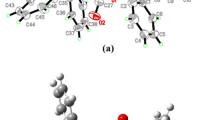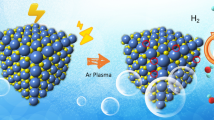Abstract
The volatilization of stibnite (Sb2S3) in nitrogen and mixtures of nitrogen-oxygen was investigated in the temperature range 973 K to 1423 K (700 °C to 1150 °C). The overall volatilization reaction study was carried out using a thermogravimetric analysis technique under various gas flow rates. The results indicated that in an inert atmosphere, stibnite can be volatilized most efficiently as Sb2S3(g) with a linear rate up to about 1173 K (900 °C). At temperatures above 1223 K (950 °C), stibnite decomposes to antimony and sulfur gas, impairing the antimony volatilization. For linear behavior in nitrogen gas, kinetic constants were determined, and an activation energy of 134 kJ/mol was calculated for the volatilization reaction. However, in the presence of oxygen, antimony can be volatilized efficiently as valentinite (Sb2O3) at low oxygen concentrations (approximately 1 to 5 pct) at approximately 1173 K to 1223 K (900 °C to 950 °C); otherwise, at higher partial pressures of oxygen, the volatilization of antimony is limited by the formation of nonvolatile cervantite (SbO2). In highly oxidizing atmospheres, a high vaporization of antimony could be achieved only at temperatures higher than 1423 K (1150 °C) where cervantite becomes unstable and decomposes into SbO(g) and 0.5O2(g).














Similar content being viewed by others
References
L. Winkel, J. Wochele, C. Ludwig, I Alxneit, and M Sturzenegger: Miner. Eng., 2008, vol. 21, no. 10, pp. 731-42.
A. Vartiainen, P. Taskinen, and A. Jokilaakso: H.H. Kellog International Symposium, Quantitative Description of Metal Extraction Processes, Eds. N.J. Themelis and P.F. Duby, TMS, Warrendale, PA, 1991, pp. 45-63.
Z. Zivkovic, N. Strbac, D. Zivkovic, D. Grujicic, and B. Boyanov: Thermochim. Acta, 2002, vol. 383, pp. 137-43.
Y. Hua, Y. Yang, and F. Zhu: J. Mater. Sci., 2003, vol. 19, no. 6, pp. 619-22.
L. Komorova, A. Holmstrom, and I. Imris: Scand. J. Metall., 1985, vol. 14, pp. 103-12.
J. Mauser: Metall. Trans. B, 1982, vol. 13B, pp. 511-13.
T. Li and J.P. Hager: Reinhardt Schuhmann International Symposium, TMS, Warrendale, PA, 1986, pp. 845-68.
G.A. Brooks, W.J. Rankin, and N.B. Gray: Metall. Mater. Trans. B, 1994, vol. 25B, pp. 873-84.
A. Roine: HSC Chemistry 5.1, OutoKumpu Research Oy, Pori, Finland, 2002.
I. Barin: Thermochemical Data of Pure Substances, VCH Verlagsgesellschaft, Weinheim, Germany, 1989.
I. Barin: Thermochemical Data of Pure Substances, VCH Verlagsgesellschaft, Weinheim, Germany, 1993.
Glushko Thermocenter of the Russian Academy of Sciences, IVTAN Association, Izhorskaya 13/19, 127412, Moscow, Russia, 1994.
O. Knacke, O. Kubaschewsky, and K. Hesselman: Thermochemical Properties of Inorganic Substances, 2nd ed., Springer-Verlag, Berlin, Germany, 1991.
Scientific Group Thermodata Europe (SGTE), Grenoble, France, 1994.
Landolt-Bornstein: Thermodynamic Properties of Inorganic Material, SGTE, Springer-Verlag, Berlin, Germany, 2001.
I. Barin: Thermochemical Data of Pure Substances, VCH Verlagsgesellschaft, Weinheim, Germany, 1995.
L. Pankratz: Bulletin No. 672, U.S. Bureau of Mines, Washington, DC, 1982.
V.G. Trofimov, A.I. Sheinkman, and G.V. Kleshchev: Izvestiya VUZ Fizika, 1973, vol. 3, pp. 135-37.
Acknowledgment
The authors acknowledge the National Fund for Scientific and Technological Development (FONDECYT) of Chile for the financial support of this research through Project #1080296.
Author information
Authors and Affiliations
Corresponding author
Additional information
Manuscript submitted March 23, 2010.
Rights and permissions
About this article
Cite this article
Padilla, R., Ramírez, G. & Ruiz, M.C. High-Temperature Volatilization Mechanism of Stibnite in Nitrogen-Oxygen Atmospheres. Metall Mater Trans B 41, 1284–1292 (2010). https://doi.org/10.1007/s11663-010-9429-6
Published:
Issue Date:
DOI: https://doi.org/10.1007/s11663-010-9429-6




